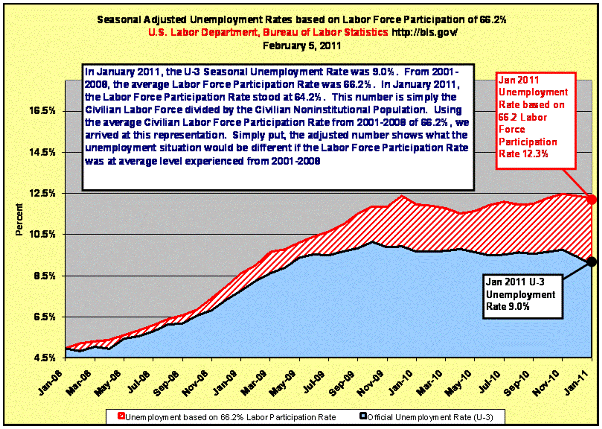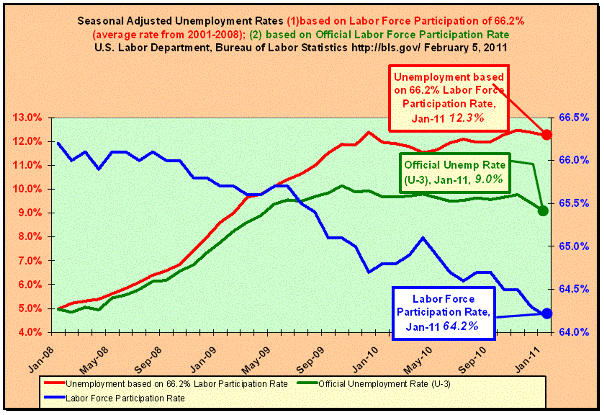February 6, 2011
For a downloadable version, click the following:
IF THE UNEMPLOYMENT RATE IS REALLY FALLING, WHY ARE SO MANY PEOPLE STILL OUT OF WORK? THE DEVIL IS IN THE DETAILS.
IS IT A CASE OF SMOKE AND MIRRORS?
Here are the numbers, you decide.

Data extracted from Department of Labor, Bureau of Labor Statistics
February 5, 2011
Employment Situation – January 2011
bls.gov/news.release/pdf/empsit.pdf
Additional information about the household survey can be found at www.bls.gov/cps/documentation.htm
- Civilian Noninstitutional Population = 238,704,000
Persons not in the labor force combined with those in the civilian labor force constitute the civilian noninstitutional population 16 years and over. (There is no upper age limit.)
- Civilian Labor Force = 153,186,000
The civilian labor force is the sum of employed and unemployed persons. Those not classified as employed or unemployed are not in the labor force.
- Civilian Labor Force Participation Rate = 64.2
(153, 186,000 divided by 238,704,000 = 64.2%)
The labor force participation rate is the labor force as a percent of the population, and the employment-population ratio is the employed as a percent of the population.
- Employed = 139,323,000
People are classified as employed if they did any work at all as paid employees during the reference week; worked in their own business, profession, or on their own farm; or worked without pay at least 15 hours in a family business or farm. People are also counted as employed if they were temporarily absent from their jobs because of illness, bad weather, vacation, labor-management disputes, or personal reasons.
- Unemployed = 13,863,000
People are classified as unemployed if they meet all of the following criteria: they had no employment during the reference week; they were available for work at that time; and they made specific efforts to find employment sometime during the 4-week period ending with the reference week. Persons laid off from a job and expecting recall need not be looking for work to be counted as unemployed. The unemployment data derived from the household survey in no way depend upon the eligibility for or receipt of unemployment insurance benefits.
- Unemployment Rate = 9.0% (U-3)
The unemployment rate is the number unemployed as a percent of the labor force.
From January 2001 through December 2008, the Labor Force Participation Rate averaged 66.2%. From January 2009 through January 2011, the Labor Force Participation Rate averaged 65.0%.
Is a profound change occurring in our culture to cause the Labor Force Participation Rate to fall this drastically? Recall the profound change ushered in by the large scale introduction of women into the workforce during World War II, i.e., witness the late "Rosie the Riveter," aka, Geraldine Doyle http://www.freep.com/article/20101231/NEWS08/12310337/Geraldine-Doyle-inspiration-Rosie-Riveter-dies.
Or is it that the so-called discouraged worker is not being counted correctly?
Let’s take another look…
The Average Labor Force Participation Rate from Jan 2001 through Dec 2008 = 66.2%
Overlaying the 66.2% on the Civilian Noninstitutional Population of 238,704,000 we arrive at a Civilian Labor Force of 158,107,000
The difference between the official Civilian Labor Force (based on 64.2% participation rate 153,186,000) and the adjusted Civilian Labor Force(based on 66.2% participation rate of 158,107,000) = 4,921,000
If we add the 4,921,000 to the ranks of the unemployed, the unemployment number increases to 18,784,000 and the U-3 version of the unemployment rate swells from the official 9.0% to 12.3%.

FYI - official U-6 is 16.1%. Using the same rationale, you could simply tack on another 3.3%, pushing the adjusted U-6 to 19.3%
Additional note: since “the sum of the employed and the unemployed constitutes the civilian labor force,” it’s a straight addition of the 3.3% (9.0% +3.3% = 12.3% at the 66.2% Labor Participation Rate)
U-3 = Total unemployed, as a percent of the civilian labor force (typically reported [official] unemployment rate).
U-6 = Total unemployed, plus all persons marginally attached to the labor force, plus total employed part time for economic reasons, as a percent of the civilian labor force plus all persons marginally attached to the labor force.
From a previous newsletter…
2010 Volume Issue 1
September 23, 2010
HERE WE GO AGAIN
www.econnewsletter.com/sep232010
A stubborn and severe recession is exacerbating the dismal job outlook and causing accelerated early retirements from the labor force, seeking long term disability status, and an increasing reality of very long duration unemployment.
www.socialsecurity.gov/policy/docs/chartbooks/fast_facts10.pdf



